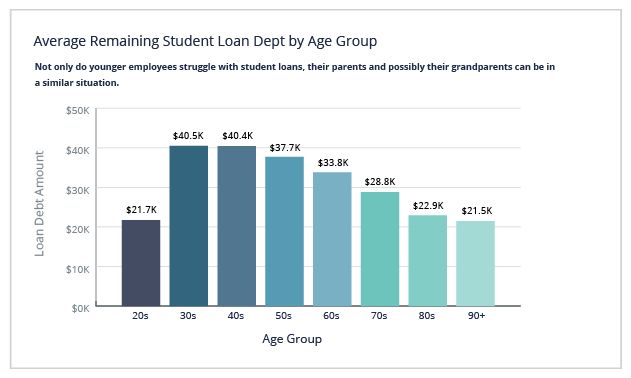Blog
Simplifying Student Debt Loan Payoff
Student loan debt is a complex issue for both employees and employers. Employees must live with the overwhelming burden of paying off the loan in addition to paying personal expenses. However, employers who offer valuable educational benefits incur the administrative burdens of managing their program as well as teaching employees how to use the benefit.
For instance, over half of employers (56%) offer undergraduate or graduate school tuition reimbursement, but only about 25% of interested employees start the tuition reimbursement process with their employer. Most employees are likely to stay with their employer because of tuition reimbursement benefits, especially when benefits can amount to over $5,000. Still, they may not participate in those programs if they are too complex.
Employers are challenged to offer impactful, simplified programs that reduce financial stressors in an easy-to-manage benefit program. Understanding the root causes of the growing student loan crisis helps employers understand why these programs are so beneficial.
Consider that student loan debt is not limited to those fresh out of college. Adults in their prime earning years, aged 30-45 years, owe half of all outstanding student debt. Interest and fees add to their loans, with the average 35-year-old’s loan being 287% more than the original value, making it even more difficult to reach a zero balance. In the same years that employees are raising a family and climbing the career ladder, they must choose between paying off a student loan, paying for current expenses, or addressing the burden of saving for retirement, increasing financial pressures.

Source: educationdata.org
Student loan holders got a reprieve during the pandemic thanks to the federal CARES Act, which put a moratorium on loan payments in 2020. However, the Secure Act 2.0 addressed retirement savings and student loan debt, allowing employees to make retirement payments toward student loans. Employers could match these contributions, making them doubly beneficial to employees. In addition, the government put student loan repayments on pause, and a recent ruling extended this program through August 31, 2022, reducing the risk of delinquency and defaults. As student loan payments get back on track, employers should continue to help employees relieve this ongoing burden.
Employees who stay with their employers often decide to postpone retirement, as nearly 40% of employees are considering. While companies want to keep valuable employees, workers who delay retirement can incrementally cost their employers over $50,000 in salary and benefits. Student loans delay most life events such as buying a house, having kids, and saving for retirement. The sooner the loans are gone, the sooner employees can save for these events and retire.
There is no avoiding the fact that employee finances dramatically impact employer finances. The sooner that employers act to solve these complex problems, the more money they will save, making more significant strides to stay competitive. Student loan assistance quickly becomes a valuable tool that reduces debt and pervasive financial stress.
In 2018, 768 million vacation days went unused, with over 236 million days entirely forfeited, amounting to $65.6 billion in lost benefits. The remaining 532 million vacation days stayed on company books as a liability, which continues to grow as employees earn more PTO time than they can use. The result is that employers owe their workforce the value of those days but often cannot pay those funds under a traditional PTO program. The average amount owed to employees is $1,898 per employee, or as much as $12,000 per worker in some companies.
Converting the value of outstanding PTO days to student loan payments is a winning proposition for both employers and employees. Employees benefit by accessing money now to pay down student loan debt, while employers enhance engagement as they improve their bottom line. One program allows employees to convert the value of unused PTO days into student loan payments that amount to several thousand dollars per year. Employers will want to ensure that employees still take time off to maintain a work-life balance while being compliant with state PTO conversion laws. In addition, some employers now put a cap on PTO hours and balance the administrative burden of adding new benefit programs. However, the benefits are substantial, with 68% of employees reporting that they would consider not leaving their employer if they had access to student loan benefits. By offering these programs, employers reduce recruiting costs, increase retention, and improve employee engagement.
Similarly, companies like Abbott Labs have allowed employees to pay off student loans under their 401(k) program, providing employer-matching amounts. However, one downside for the employee is that since they are paying off debt, they miss out on the compound interest they would receive by contributing to a 401(k) investment.
A Pew Charitable Trust study focused on the reasons for student loan repayment issues. While the primary reason for getting off track with payments was financial instability, other reasons included not being prepared to manage loan repayment, such as not knowing a payment was late until the loan servicer sent notice. Understanding, enrolling in, and managing income-based repayment plans was another difficulty, as was pausing payments in times of financial stress. Solutions to these problems included providing borrowers with consistent, accurate, relevant, and timely information and user-friendly guidance to assist with complex decisions.
New companies are coming forward to make it easier to manage and pay student loans. FutureFuel.io provides an all-in-one toolbox that helps employees “crush student debt in the workplace and beyond.” They centralize student loans in one platform, making it easier for employees to see, manage, and pay off student loans. By making loans visible and easier to manage, employees improve their chances of paying off student loans instead of just being distracted by them.
- Roll up all their loans, from multiple servicers, in one place, managing where contributions go. With all loans in one place, they can compare the highest interest loans, paying them off faster and saving money in interest.
- Reassess their loans by switching to the right repayment plans and saving. With all information in one place, employees can easily see eligibility requirements for all government-sponsored loans, saving on average $326/month.
- Round Up lets users save change from everyday purchases, using customizable goals, applying the change toward loan payoff. As a result, the average user will save over $6,000 and pay off loans five years faster.
- Invite others to pay off loans or contribute to the loans of others.
- Auto Crush helps users pay off loans more quickly by adding extra payments, with FutureFuel handling all scheduling and automatically sending payments.
- Read smart tips and educational content about complex student loan topics, overcoming the struggle of contacting loan account servicers.
- Get coaching from student debt subject matter experts, including 1:1 access to help create a personalized repayment plan.
- Explore refinance options in the multi-lender refi-marketplace, which has helped borrowers save $19,000 over the life of a student loan by lowering interest rates on average by 1.7%.
Employers find the program cost-effective and beneficial for their retention and culture. For instance, debt is a deterrent to diversity, with two-thirds of debt held by women and persons of color who are twice as likely not to contribute to a 401(k), according to FutureFuel research. In addition, helping employees promotes equity by helping those most affected by student loan debt burden.
Boosting employee retention with a student loan repayment benefit can help reduce new-hire turnover while leading to a competitive recruitment environment, as 50% of new hires with student loan debt want repayment assistance from their employer.
Research shows that nearly half of employees feel financially stressed, even those earning more than $100,000, resulting in complicated workplace relationships, HR issues, premature exits, and increased training costs. By implementing creative student loan payoff programs, employers can help employees balance their financial priorities for paying off student loan debt more quickly while positioning them to contribute to retirement savings sooner than later. Student debt payoff is a win-win for employers who want to attract top talent, offer unique and practical benefits, and ease employee financial stressors. If you are ready to discuss student loan debt programs for your organization, contact our team of experienced professionals who will help design a program that fits your workplace and employee needs.
Author
Table of Contents












